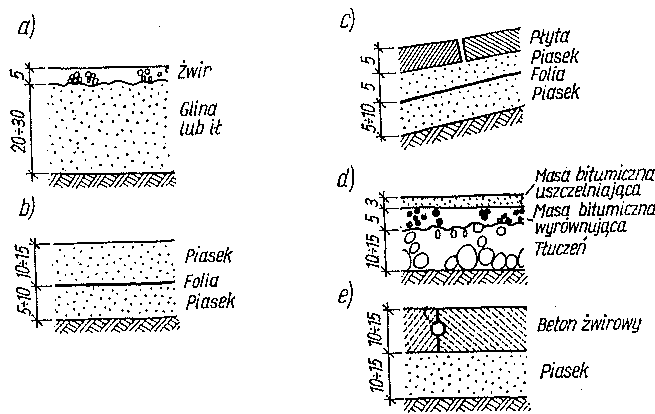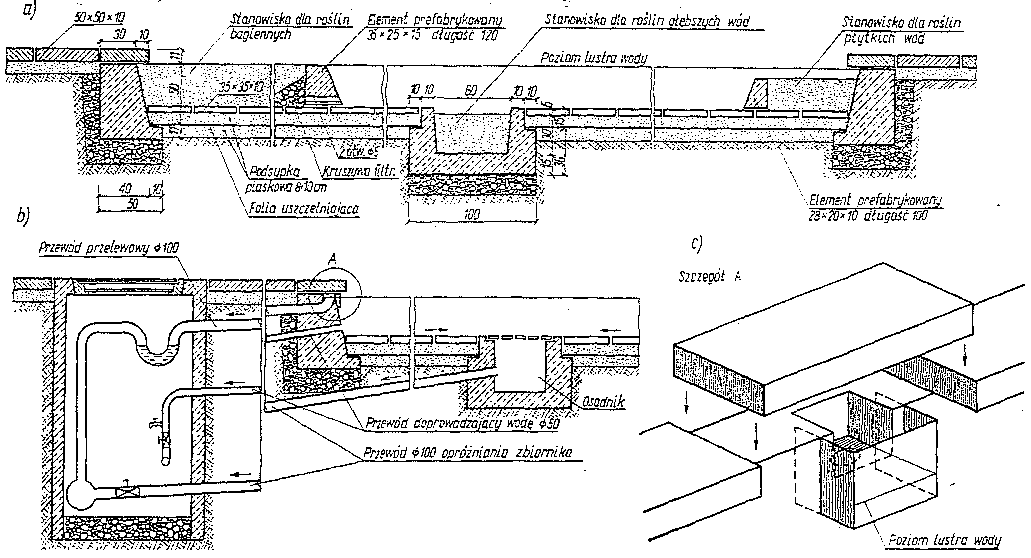 In natural tanks, whose bottom has natural tightness; It is often necessary to strengthen its surface. Most often, this strengthening is aimed at maintaining the right profile of the day and facilitate the maintenance of the tank clean. As strengthening, the floor surface is most often covered with a stone cobble. After chasing, such a strengthening can contribute to increasing the tightness of the bottom of the tank.
In natural tanks, whose bottom has natural tightness; It is often necessary to strengthen its surface. Most often, this strengthening is aimed at maintaining the right profile of the day and facilitate the maintenance of the tank clean. As strengthening, the floor surface is most often covered with a stone cobble. After chasing, such a strengthening can contribute to increasing the tightness of the bottom of the tank.
 Ways to seal the DNA of garden tanks: a) clay or Ił, b) i c) plastic foil, d) bituminous mass, e) concrete slabs.
Ways to seal the DNA of garden tanks: a) clay or Ił, b) i c) plastic foil, d) bituminous mass, e) concrete slabs.
In all artificial tanks, that is, no natural DNA, you need to make a special seal, and often also use the strengthening of the DNA surface.
The tank bottom sealing can be done with various materials, depending on the type of substrate, tank depth, purpose and use. The cheapest and at the same time the easiest method of sealing is to arrange a 20-30-centimeter layer of clay or muff. Such a layer is laid on a properly profiled and touched surface. After arrangement, and then cover with a 5-centimeter layer of gravel, which is the strengthening of the DNA. On the surface of the DNA with larger slopes, it is better to use a small crushed stone instead of gravel, which, after being fired, creates a much better strengthening layer.
Sealing with clay or iam can be used on a sufficiently concise surface and in cases of expected land settlement, np. on the embankments. In this way, the sealing should not be used on loose and permeable soils due to the ease of penetration into such a substrate of the flowing parts, which leads to the destruction of the sealing layer and water defects.
Cheap and very easy to make include sealing with plastic foil, and above all polyethylene foil. The thickness of the foil used is usually 0,05 the 0,1 mm. This type of seal can be, use on permeable and insufficiently stable lands, However, such a substrate should be properly compacted, profiled and aligned. Foil is a flexible material, but quite delicate and easy to damage, Therefore, it is usually arranged on a 5-10-centimeter layer of fine-grained sand. This layer perfectly fills the unevenness of the surface of the substrate and prevents damage to the foil under the pressure of the mass of water.
The foil intended for sealing should be a uniform coating. In order to create such a coating, the foil sheets are connected by welding. Knowing the shape and dimensions of the tank carefully, you can prepare a coating from the foil, e.g.. on the surface of the lawn or square. Two films can be used for more reliable DNA sealing. Film sealing should be thoroughly connected to the foundation of the wall of the tank.
 Artificial garden tank sealed with foil: a) cross-section, b) The arrangement of water supply and drainage cables, c) Diagram of embedding the overflow cable.
Artificial garden tank sealed with foil: a) cross-section, b) The arrangement of water supply and drainage cables, c) Diagram of embedding the overflow cable.
After spreading the foil and connecting it with the walls constituting the shore, it must be protected against mechanical damage (perforation) by arrangement: in horizontal places of the 10-15-centimeter layer of sand, and in places with larger slopes - concrete slabs on sand bed. The foil protection with boards makes it easier to keep the tank of cleanliness and can also be used in garden pools used for bathing.